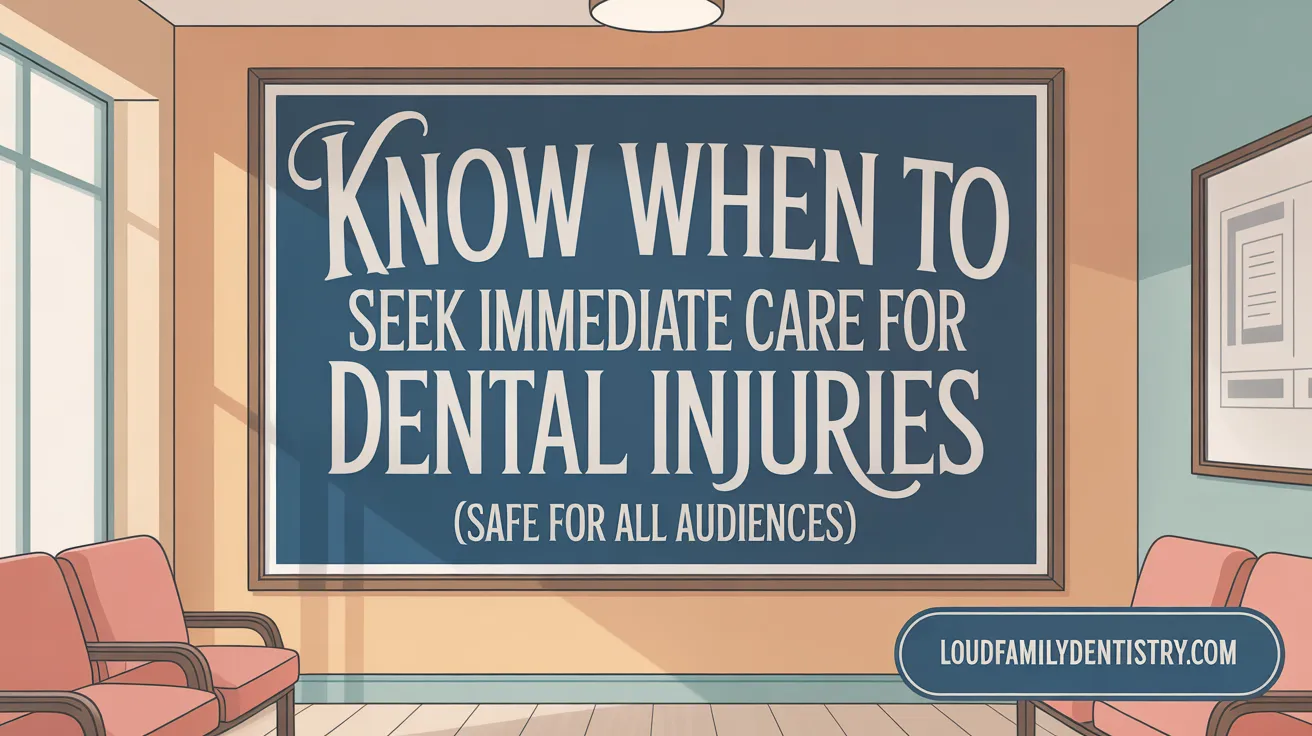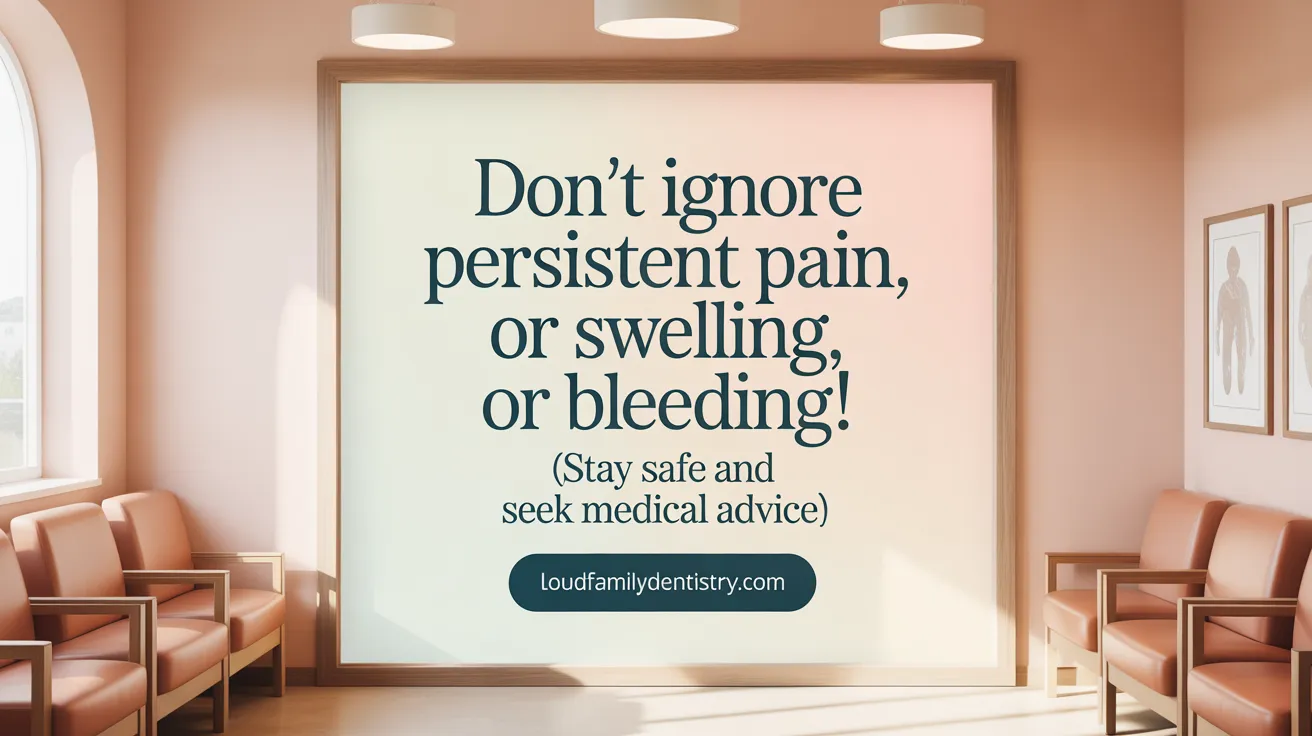Urgent Dental Care: Why Timing Matters
Dental emergencies can arise unexpectedly and require swift action to prevent severe complications including infection, tooth loss, and costly treatments. Understanding the signs that warrant urgent dental care empowers patients to act quickly and seek appropriate treatment, thereby safeguarding their oral and overall health. This article outlines key symptoms, red flags, and the steps to take when faced with potential dental emergencies.
What Constitutes a Dental Emergency?

What counts as a dental emergency?
A dental emergency involves situations where immediate care from a dentist is necessary to control pain, prevent tissue damage, or save a tooth. These cases usually require swift action to avoid serious health issues.
Common examples of emergencies
Some typical dental emergencies include:
- Severe toothache without relief from painkillers, indicating possible infection or nerve damage.
- Broken or chipped teeth resulting from trauma.
- Knocked-out (avulsed) teeth that need quick reattachment.
- Soft tissue injuries like bleeding gums, cuts, or lacerations of the lips or tongue.
- Dental abscesses causing swelling, fever, and foul taste.
- Lost or damaged crowns, fillings, or other restorations.
- Persistent bleeding from the gums.
- Facial swelling from infections.
Importance of immediate action
Acting quickly in dental emergencies is vital. It can mean the difference between saving a tooth and losing it permanently. Immediate measures include controlling bleeding, managing pain with over-the-counter medications, and keeping the affected tooth moist.
Handling emergencies before professional care
While waiting for emergency treatment:
- For knocked-out teeth, handle only the crown, not the root, and keep it moist in milk or saliva.
- For bleeding, apply gentle pressure with gauze or a clean cloth.
- Use a cold compress to reduce swelling and pain.
- Avoid touching or forcing broken teeth.
- Seek urgent care by calling your dentist or visiting an emergency room if necessary.
Understanding what constitutes a dental emergency helps ensure prompt action, which can save teeth, reduce pain, and prevent infections.
Recognizing Critical Symptoms That Require Prompt Dental Care

What are the signs that indicate the need for urgent dental care?
Severe and persistent tooth pain is often an indicator of underlying issues such as infections, nerve damage, or deep cavities. If the pain continues despite over-the-counter pain relief or worsens over time, it is crucial to seek immediate dental treatment.
Swelling in the gums, face, or jaw, especially when accompanied by fever or severe pain, suggests an abscess or other serious infections that need prompt attention to prevent spread or further complications.
Uncontrollable bleeding from the mouth or gums that does not stop after applying pressure indicates a serious injury or gum disease requiring urgent care. Persistent bleeding lasting more than 10 minutes is a clear sign to visit a dentist right away.
Difficulty chewing or swallowing can be symptoms of infections, abscesses, or trauma in the mouth. These problems can compromise airway safety, especially if swelling increases.
Signs of infection such as bad taste, foul odor, redness, or pus around the affected area point to underlying abscesses or gum disease that need urgent treatment to prevent systemic infection.
Damaged or lost dental restorations like crowns, fillings, or bridges expose the underlying tooth structure to bacteria, leading to further decay or infection. Addressing these promptly helps protect oral health and restore function.
Severe and persistent tooth pain is often a symptom of deeper dental problems like decay or abscess, and requires immediate care.
Swelling can signal serious infections, especially when facial or jaw swelling occurs with pain.
Bleeding that won't stop suggests trauma or gum disease needing urgent treatment.
Difficulty in chewing or swallowing might be due to swelling or injury, indicating the need for emergency assessment.
Signs of infection include pus, bad taste, and fever, which can worsen if not treated promptly.
Damaged or lost restorations such as crowns or fillings should be addressed quickly to prevent additional damage or bacterial invasion.
It is essential to contact your dentist immediately if you experience these symptoms. Recognizing early signs and acting swiftly can prevent more severe health issues and improve the chances of saving damaged or knocked-out teeth.
Dental Infections: Red Flags You Should Never Ignore

What are the red flags for a dental infection?
Dental infections can escalate quickly if not treated promptly. Recognizing the warning signs is essential for seeking immediate care.
Systemic symptoms such as fever, malaise, chills, or general feeling of illness often indicate that the infection is spreading beyond the tooth. These signs suggest the need for urgent medical and dental attention.
Locally, severe pain that persists, especially if it worsens over time, can be a sign of an abscess or deep cavity infection. Difficulty chewing, swallowing, or speaking are additional indicators of serious infection.
Other critical signs include trismus, which is difficulty opening the mouth due to muscle spasms, and halitosis, or bad breath, indicating an active infection.
Facial swelling, especially around the jaw, neck, or underneath the tongue, can be life-threatening if it compromises the airway. This swelling often accompanies a foul taste or pus discharge.
In cases where swelling progresses rapidly, leading to difficulty breathing, drooling, or loss of voice, immediate emergency medical care is vital.
These warning signs underscore the importance of prompt intervention to prevent complications such as deep neck space infections or airway obstruction.
| Sign or Symptom | Description | Urgency Level |
|---|---|---|
| Fever and chills | Indicate spreading infection | High |
| Facial swelling | Risk of airway compromise | Very High |
| Difficulty swallowing or breathing | Emergency sign | Critical |
| Persistent severe pain | Possible abscess | Urgent |
| Trismus (limited mouth opening) | Deep infection | Urgent |
Timely treatment by dental and healthcare providers can prevent worsening of these conditions and preserve health.
How to Manage Common Dental Emergencies Before Professional Help Arrives
First aid steps for severe toothache
If you experience a severe toothache, start by rinsing your mouth with warm water to clear any debris. Gently remove any lodged food with dental floss, avoiding poking or forcing the floss into the gum. Applying a cold compress to the cheek or jaw can help reduce swelling and alleviate pain.
Over-the-counter pain relievers, like ibuprofen or acetaminophen, can be taken to manage discomfort. If the pain persists beyond a few hours or is accompanied by swelling, fever, or pus, seek emergency dental care immediately, as these signs may indicate an infection.
Handling knocked-out or cracked teeth
A knocked-out tooth is a dental emergency. Carefully pick up the tooth by the crown (the top part), avoiding touching the root. Rinse it gently with milk or saline solution and try to reinsert it into the socket if possible. If reinsertion isn’t feasible, store the tooth in milk or a special preservation medium.
For a cracked or broken tooth, rinse your mouth with warm water and save any broken pieces. Control bleeding with gauze or a clean cloth, and apply a cold compress to reduce pain and swelling. Visiting a dentist promptly is crucial to prevent further damage or infection.
Rinsing and cold compress use
During dental emergencies, rinsing your mouth with warm saltwater can help reduce bacterial buildup and ease pain, especially in cases of abscess or soft tissue injury. Cold compresses or ice packs should be applied to the face or jaw for 15-minute intervals to decrease swelling and numb pain.
Temporary fixes for lost restorations
If a crown, filling, or other restoration falls out, retain the pieces and keep them clean. You can temporarily fix crowns using dental cement or, if unavailable, stick the restoration in place with sugarless gum. Avoid chewing with the affected tooth until your dentist can properly repair or replace the restoration.
When to go directly to emergency care
Seek immediate dental attention if you experience uncontrolled bleeding, swelling that worsens, a knocked-out tooth not stored properly, or severe facial trauma. Symptoms like difficulty breathing or swallowing, persistent pain, and signs of infection such as fever or pus also require urgent care.
Prompt management and timely professional treatment can prevent irreversible damage, alleviate pain, and improve the chances of saving your natural teeth during dental emergencies.
Can Urgent Care Centers Handle Dental Emergencies? Understanding Your Options
Can urgent care centers handle dental emergencies?
Urgent care centers are available for addressing certain dental urgencies, especially cases involving severe pain, swelling, or infections. They can provide initial treatment such as pain relief, controlling bleeding, and addressing infections temporarily. However, these facilities usually do not have dedicated dental specialists or advanced equipment like dental X-rays, root canal tools, or crowns.
For example, if you experience a severe toothache caused by infection or am accidental bite, an urgent care clinic can stabilize your condition. They might offer antibiotics or pain medications but cannot perform complex procedures like repairing broken teeth or re-implanting knocked-out teeth. In cases of dental trauma like chipped, cracked, or knocked-out teeth, it is best to see a dentist immediately, ideally within an hour, to maximize the chances of saving the tooth.
Symptoms like loose teeth, continuous bleeding, or oral sores need specialized assessment and treatment. While urgent care centers can provide short-term relief, they are not equipped for definitive dental repairs. Therefore, when facing complex or serious dental injuries, visiting a dental emergency clinic or contacting a dental specialist offers the comprehensive care needed to prevent further damage or loss of teeth.
Understanding this distinction can help you respond promptly and appropriately to dental emergencies, ensuring that you get the right treatment at the right time.
Timely Recognition and Response Protects Your Dental Health
Recognizing the signs that necessitate urgent dental care is crucial for preventing pain, infection, and irreversible damage to your teeth and gums. Whether it is a severe toothache, trauma such as a knocked-out or cracked tooth, persistent bleeding, or signs of infection, prompt professional intervention significantly improves outcomes. While urgent care centers might provide immediate relief for certain symptoms, emergency dental clinics offer specialized treatment that can save teeth and restore oral health. When in doubt, contact your dentist immediately—quick and informed action is your best defense against long-term dental complications.
References
- What Is a Dental Emergency and Where To Go for Care
- 6 Signs That You Need to See an Emergency Dentist
- 10 Signs You Need to See an Emergency Dentist Immediately
- Do You Need Emergency Dental Care | Colgate®
- The Top 5 Reasons You Might Need Emergency Dental Care
- 10 Urgent Signs You Need to See a Dentist Immediately | Gloss Dental
- 7 Signs You Need Emergency Dental Care - Marks Family Dentistry
- Urgent Signs You Need to See a Dentist - One Eleven Dental
- Emergency Dental Care: When Should You Call Your Dentist?
- 5 Signs You Need Emergency Dental Care ASAP
